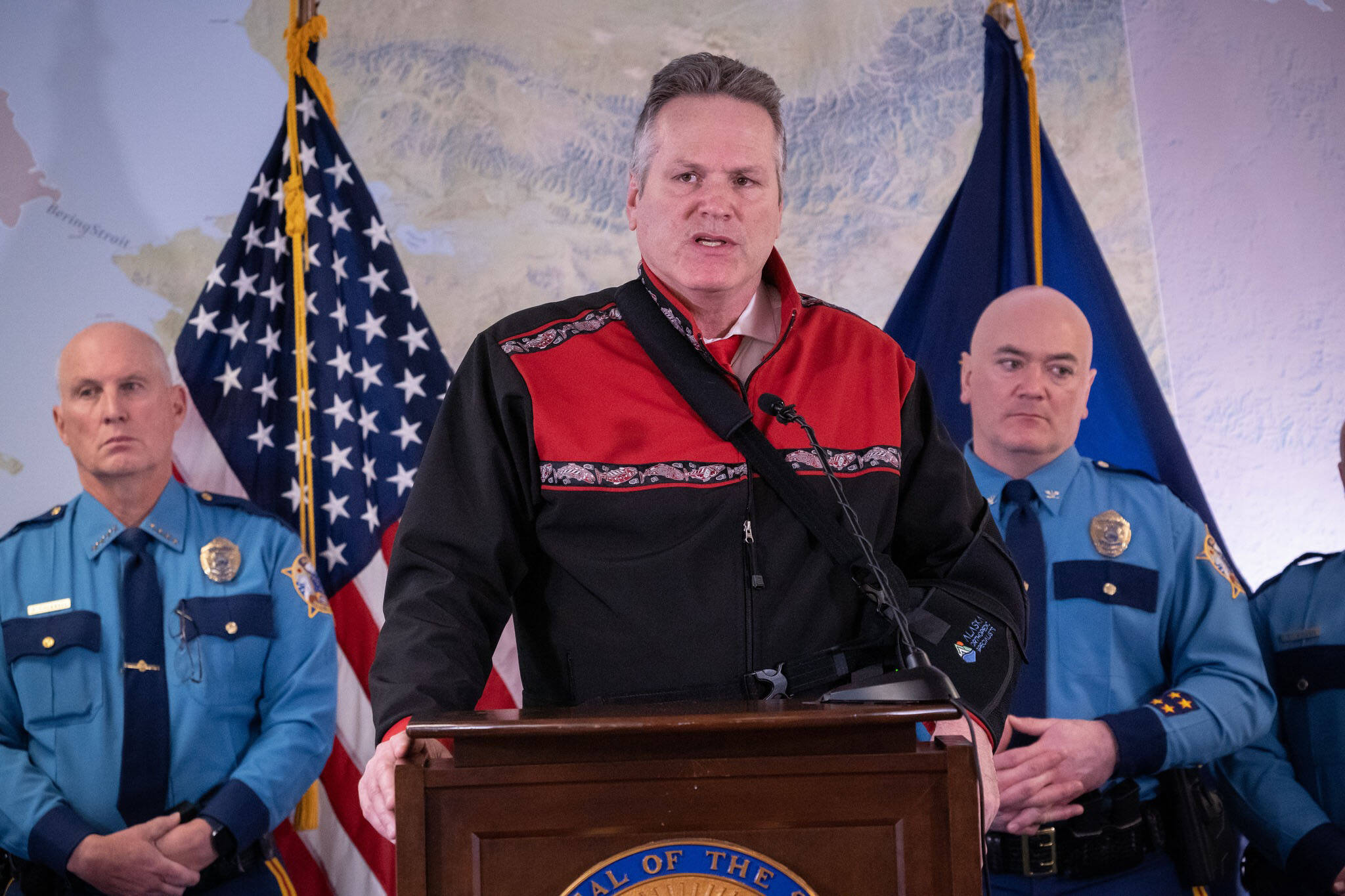A $2,564 dividend, millions for the stabilization of the Kenai bluff and full funding for public education are among the highlights of Gov. Mike Dunleavy’s proposed budget for the upcoming fiscal year, which was presented Wednesday.
The theme of the nearly $11 billion budget is “To the Future” and lays out the state’s priorities, Dunleavy said Tuesday. The $10.9 billion total includes roughly $4.6 billion in federal funding, about $4.6 billion in unrestricted general funds, $912 million in designated general funds and $792 million in other state funds.
The large portion of federal funding, Dunleavy said, is a result of the COVID-19 pandemic, namely federal efforts to help with economic recovery. He said that while he doesn’t expect such an influx of federal funds regularly, he sees the funds as an opportunity to “shore up” the state’s economy.
“We don’t anticipate this is going to be a yearly occurrence,” Dunleavy said.
He emphasized Wednesday that the budget figure marks a 7% decrease in overall state spending compared to the fiscal year 2019 budget and said the state is “on track” to finish the current fiscal year with a surplus for the first time since 2012.
One of the areas most clearly prioritized is public safety. Included in the FY23 budget proposal is about $3 million for 10 new Village Public Safety Officer positions, 15 new Alaska State Trooper positions with a final appropriation to be worked out with lawmakers, $5.1 million to purchase new body and vehicle cams for law enforcement and $6.3 million for domestic violence and sexual assault prevention programs.
The proposed budget also includes fully funding the base student allocation formula, which helps determine the amount of money given to local school districts by the state, fully funding school bond debt reimbursement and about $55 million for the replacement of a school in Napakiak, where erosion caused by the Kuskokwim River has already vacated some classrooms.
Dunleavy is also proposing $1.7 billion for 2022 PFD payments of $2,564 for each eligible Alaskan. That amount, Dunleavy’s office said in a release, reflects his 50/50 dividend plan, via which money from the Alaska Permanent Fund would be split 50/50 between the dividend and state services.
The proposal also includes $6.5 million in funding for stabilization of the Kenai bluff, which would complete the City of Kenai’s local financial match for the project at current estimates. The city has previously said it hopes to pursue federal funding for the project under the $1 trillion infrastructure bill signed into law last month.
Kenai City Manager Paul Ostrander said Wednesday that while there are still contingencies the could stand in the way, the city is excited to see the project in the proposed budget. He wrote in a Dec. 7 memo to Jill Schaefer, of Dunleavy’s regional office, that while the project has a preliminary cost estimate of $42 million, the anticipated cost is between $25 million and $35 million. City administration, Ostrander wrote, is using $30 million for planning purposes.
At that estimate, the city would be required to put up a local match of $10.5 million, $4 million of which has already been secured.
“Funds from the State of Alaska could help make this project a reality, a project that has been the City of Kenai’s number one capital priority for at least three decades,” Ostrander wrote. “Buildings and infrastructure have been lost as a result of the erosion, and capital investment in an area which would otherwise be significant, is negligible. This project would immediately create increased property values and spur investment in an area that is arguably the jewel of the Peninsula.”
The budget proposal also includes funding for safety improvements to a stretch of the Sterling Highway between Sterling and Soldotna that has been designated as a “Traffic Safety Corridor” due to the high rates of fatal and major injuries.
The budget package is subject to approval by the Alaska Legislature, which reconvenes for the second regular session on Jan. 18, 2022.
Speaker of the House Rep. Louise Stutes, R-Kodiak, said in a statement Wednesday that the one-time funds included in Dunleavy’s budget proposal will not “fundamentally alter Alaska’s budget reality.” Among other things, Stutes said the Legislature will need to “carefully review” the proposal to make sure it pencils out, that federal funds are used appropriately and that revenue projections are realistic.
“It is important to remember that a slight rise in the price of oil, changes in the stock market, and one-time funding from Washington do not fundamentally change Alaska’s fiscal reality,” Stutes wrote. “We need to make the tough decisions on a fiscal plan in order to provide sustainability in budgeting and the PFD.”
More information about the budget package and process can be found at the state’s Office of Management and Budget at omb.alaska.gov/fiscal-year-2023-proposed-budget/.
Reach reporter Ashlyn O’Hara at ashlyn.ohara@peninsulaclarion.com.

